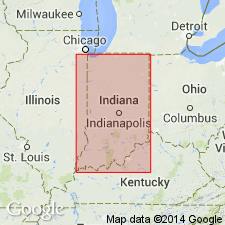
- Usage in publication:
-
- Clegg Creek member
- Modifications:
-
- First used
- Dominant lithology:
-
- Shale
- AAPG geologic province:
-
- Cincinnati arch
Summary:
Name Clegg Creek member, uppermost member of New Albany shale, introduced here for massive carbon-rich silty or dolomitic pyritic shale. Overlies Camp Run member (new). Type locality and derivation of name not stated.
Source: GNU records (USGS DDS-6; Reston GNULEX).
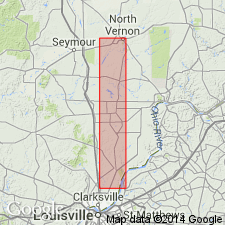
- Usage in publication:
-
- Clegg Creek Member
- Modifications:
-
- Named
- Dominant lithology:
-
- Shale
- AAPG geologic province:
-
- Cincinnati arch
Summary:
Name Clegg Creek Member of New Albany Shale formally proposed in this report. Type section designated 2 mi southeast of Henryville in Clark Co, southeastern IN. Name from tributary to Silver Creek. Member is composed of brownish-black finely laminated organic-rich, pyritic shale. Overlies newly named Camp Run Member; underlies Rockford Limestone. Includes Falling Run, Underwood, Henryville, and Jacobs Chapel Beds, all reduced in rank. Thickness about 40 ft. Age is Late Devonian and Early Mississippian.
Source: GNU records (USGS DDS-6; Reston GNULEX).
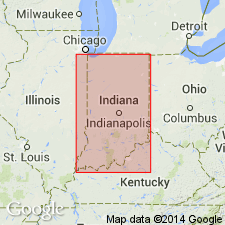
- Usage in publication:
-
- Clegg Creek Member
- Modifications:
-
- Overview
- Biostratigraphic dating
- AAPG geologic province:
-
- Cincinnati arch
Summary:
Consists of brownish-black to black, finely laminated, pyritic, organic-rich shale. Contains highest concentrations of organic material in New Albany Shale. Contains a few greenish-gray shale or mudstone beds near top. Thickness is about 40 ft (12 m) thick in Jackson, Scott, and Clark Cos., and thins southward to 22 ft in Harrison Co. (Hasenmueller, 1982). Overlain by Rockford Limestone. Overlies Camp Run Member of New Albany Shale. Includes upper part of Blackiston Formation, all of Sanderson Formation (including Falling Run Member), Underwood and Henry Formations, and Jacobs Chapel Shale of Campbell (1946). Falling Run, Underwood, Henry, and Jacobs Chapel are recognized as formal beds in upper part of Clegg Creek Member (Lineback, 1970). Underwood Bed bears conodonts typical of SIPHONODELLA SULCATA Assemblage Zone of Kinderhookian age. Devonian-Mississippian boundary is at or below base of bed. That part of Clegg Creek just below Falling Run Bed is equivalent to upper part of Grassy Creek Shale, Saverton Shale, and Louisiana Limestone of IL. Underwood, Henryville, and Jacobs Chapel Beds contain conodonts that allow correlation with Hannibal Shale of MO. On the basis of PROTOSALVINIA (FOERSTIA), found about 20 ft above base of Clegg Creek in Indiana, tentative correlation is made with Antrim Shale (Michigan basin), Huron Member of Ohio Shale (OH and KY), and upper part of Gassaway Member of Chattanooga Shale (TN) (Hasenmueller and others, 1983).
Source: GNU records (USGS DDS-6; Reston GNULEX).
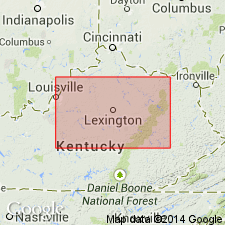
- Usage in publication:
-
- Clegg Creek Member
- Modifications:
-
- Areal extent
- Overview
- AAPG geologic province:
-
- Illinois basin
Summary:
Authors follow de Witt (1981) in restricting the New Albany Shale to the Illinois basin and the Ohio Shale to the Appalachian basin. Ohio Shale terminology used wherever Three Lick Bed is recognizable in cores. Unlike de Witt (1981), authors do not use Chattanooga Shale in Knobs outcrop area of south-central KY. Most of New Albany correlates with the Huron Member of Ohio Shale. Upper 1 to 2 m correlates with Cleveland Member. New Albany subdivided into (ascending) Blocher, Morgan Trail, Camp Run, and Clegg Creek Members.
Source: GNU records (USGS DDS-6; Reston GNULEX).

- Usage in publication:
-
- Clegg Creek Member
- Modifications:
-
- Overview
- AAPG geologic province:
-
- Illinois basin
Summary:
In the outcrop area of the New Albany Shale of southeastern IN, the Morgan Trail, Camp Run, and Clegg Creek Members are differentiated above the Selmier Member. They are also recognized in the subsurface of west-central KY. Together the three members reach a thickness of 140 ft in Posey and Vanderburgh Cos, IN, but thin to 60 ft in central and northern IN. They are mapped as undifferentiated in southwestern IN. The three are thought to be equivalent to the Grassy Creek of southeastern IL. In Jackson, Scott, and northern Clark Cos, the Clegg Creek is about 40 ft thick. Member thins southward to 22 ft in Harrison Co. A bed of greenish-gray shale 7.5 ft below the top of the Clegg Creek in Jackson Co. has been correlated with the Louisiana Limestone of western IL. Conodont faunas indicate that the uppermost beds of the Clegg Creek are equivalent to the Hannibal Shale of western IL and MO. In southern IN and west-central KY, includes the Falling Run, Henryville, and Jacobs Chapel Beds at top. Underwood Bed overlies Falling Run Bed in its immediate type area of Clark Co., IN. Unit is Late Devonian and Early Mississippian.
Source: GNU records (USGS DDS-6; Reston GNULEX).
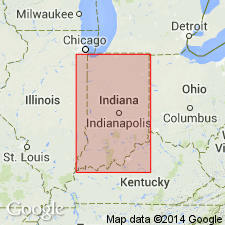
- Usage in publication:
-
- Clegg Creek Member*
- Modifications:
-
- Biostratigraphic dating
- AAPG geologic province:
-
- Illinois basin
- Cincinnati arch
Summary:
Conodont biostratigraphy indicates that the Clegg Creek Member of the New Albany Shale is of Late Devonian (Famennian) and Early Mississippian (Kinderhookian) age.
Source: GNU records (USGS DDS-6; Reston GNULEX).
For more information, please contact Nancy Stamm, Geologic Names Committee Secretary.
Asterisk (*) indicates published by U.S. Geological Survey authors.
"No current usage" (†) implies that a name has been abandoned or has fallen into disuse. Former usage and, if known, replacement name given in parentheses ( ).
Slash (/) indicates name conflicts with nomenclatural guidelines (CSN, 1933; ACSN, 1961, 1970; NACSN, 1983, 2005, 2021). May be explained within brackets ([ ]).

